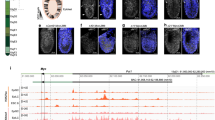Abstract
The elucidation of general parameters influencing the transcriptional activation of gene loci at distinct stages of development is an essential prerequisite for a reproducibly successful gene transfer in both gene therapy protocols and biotechnology. Up to now research has focused mostly on the identification and characterization of individual cis-regulatory elements by transient transfection and in vitro assays. However, the most relevant assay system to test gene constructs designed for gene therapy protocols is the transgenic animal. In such an experimental system exogenous genes are usually integrated randomly in the chromatin. For gene constructs not fulfilling the requirements for correct gene locus activation this can lead to genomic position effects on gene expression. The consequences are highly variable expression levels and a disturbance of temporal and spatial expression patterns. Hence it is important to examine how cis-elements function in a chromatin context, and how they cooperate during the developmentally controlled activation of an entire gene locus. One among a few gene loci which are sufficiently characterized to enable such investigations is the chicken lysozyme locus. This review summarizes recent results aimed at identifying the necessary prerequisites for a reproducibly correct expression of the lysozyme locus in transgenic mice and the implications of our findings for gene transfer. The complete lysozyme locus is expressed independent of the chromosomal position and at a high level in macrophages of transgenic mice. Correct transgene regulation requires the cooperation of all cis-regulatory elements. Chromatin of the lysozyme locus in both the active and the inactive state is highly structured. Each cis-regulatory element on the chicken lysozyme locus is organized in its own unique chromatin environment, with nucleosomes specifically placed on specific sequences. The transcriptional activation of the lysozyme locus is accompanied by extensive rearrangements of its chromatin structure, which are disturbed when the transgenes are subjects to genomic position effects. Based on these results, we propose that a complete locus is resistant to genomic position effects, and that a distinct chromatin architecture of a gene locus is required for its correct activation.
Similar content being viewed by others
Author information
Authors and Affiliations
Additional information
Received: 18 March 1996 / Accepted: 24 June 1996
Rights and permissions
About this article
Cite this article
Bonifer, C., Huber, M., Jägle, U. et al. Prerequisites for tissue specific and position independent expression of a gene locus in transgenic mice. J Mol Med 74, 663–671 (1996). https://doi.org/10.1007/s001090050070
Issue Date:
DOI: https://doi.org/10.1007/s001090050070




